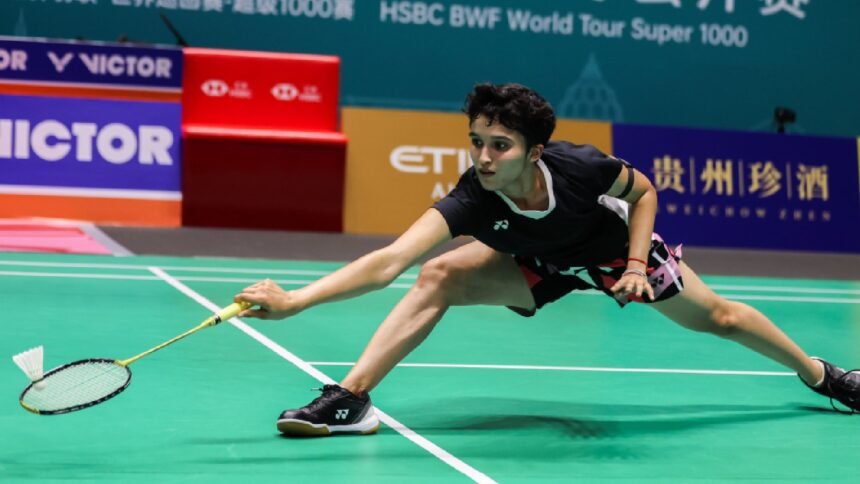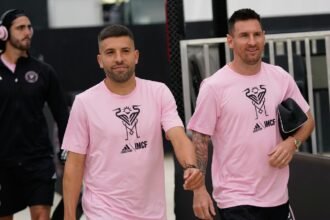Not too unlike Tanvi Sharma, Unnati Hooda has a very visible weakness at the net, which can be immediately pounced upon by an opponent. It became glaring in front of multiple World Champion and current World No 4 Akane Yamaguchi.
Hooda lost 21-16, 21-12 in 33 minutes in what proved to be a mild exertion for the supremely consistent Japanese, who is not far off the veey top levels, even if her speed is down a clip or two.
In father and coach Upkaar Hooda’s mid set advice was the crux of what was going wrong and what may be remedied. It was 8-11 in the second, and not entirely beyond Hooda’s abilities. He would say, “Woh bhaagke aa rahi hai (to the net). Usko aur peechhe bhagaa.” (Yamaguchi is easily rushing the net, push her back further.) Rustic words, but absolutely pinpoint wisdom.
Hooda, just 17, would realise – amongst the many learnings while playing top names – that it isn’t really easy to control movements of these champion players, even if the plan is on point, and it was one of the few aspects Hooda really impressed with for parts of the game. And then executing could be an altogether different matter. So her game collapsed in a pool of errors.
Net exactitude and precision can go awry at any point. It went off for Lakshya Sen these past weeks and returned next match, it’s that ephemeral. But the technique only comes from practice – of striding and shuttle control. Pushing Yamaguchi back needed a range of skills and decisions to fall into place, and Hooda literally fell short, stabbing away rushed and reeling.
“I made so many unforced errors when match was equal in some scores. Continuous two points. I tried but she was very good in her drops and she was controlling the game,” she told BWF.
The line smashing, down-the-line-hit is in place – and the kill shot, the stroke to bury the the shuttle, being in place, is a huge victory for Hooda, for she can build her winners and isn’t relying on endless retrieving. But that’s only 20 percent of the skillset required. The other 80 percent needs more than sharpening, something she would have learnt playing Yamaguchi and Wang Zhi Yi, even as she is firmly placed after making Super 1000 quarterfinals as the youngest shuttler at 17.8 years.
Story continues below this ad
“Happy to make first Super 1000 quarterfinal,” she told BWF. “But lots of learnings from this tournament and this match. It was a tiring match against Sindhu but no I had recovered well. First match against Yamaguchi. We need to be more patient while playing against her because she’s really good at her defense. So we can’t be in a hurry to win the point. We should be patient until we have the right time to attack,” Hooda said.
Till 5-5 in the opener, Hooda was keeping pace, with her straight whipped smash travelling deep, and letting Yamaguchi know she needed to retrieve at full tilt. A high service fault for Hooda at 6-6 pegged back her enthusiasm a bit, but the hop-smash with lot of power lent to it kept her in it even after trailing 7-11.
In the long rallies, Hooda still stood a chance if the speed and accuracy at speed were blended. But what had helped Yamaguchi break away at 6-7 had been a net error she drew out as Hooda was caught between a desperate lift and flicking it closer. From that point on, the Japanese knew where the easier points would come from – the net.
Where the Indian did well was once again attacking the mighty Yamaguchi of all people, on awkward body defense, one of her best traits. She could kill a mosquito in her sleep in tropical places, she’s that good at parrying. But Hooda found the angle to get to 11-12.
Story continues below this ad
Like Hooda said later, the errors came if not in clumps in pairs and all the hard work would be rendered undone. And then there were times like 11-13 when nobody could have picked that Yamaguchi exquisite drop, unleashed non chalantly.
At 16-19, Hooda lured her opponent into a long rally with some high standard defensive retrieving, and even drew out a net error. But Yamaguchi got back with a perfect net chord and Hooda’s clear went wide next to give the 28-year-old the opener.
Like Tanvi and Anmol Kharb, Hooda has a good understanding of how to scatter opponents on the back court, and a reliable kill shot. But like her peers, the net game will need massive work to truly take control of rallies against the biggest names. What Hooda can take hope from is that everyone from Saina Nehwal, PV Sindhu to Lakshya Sen – with exceptions of Kidambi Srikanth and Ayush Shetty now – arrived on the international circuit with a still-developing net game, lost matches to that weakness, and then bolstered it by leaps and bounds.
Hooda will need to learn it as she goes – whether she chooses a big academy or continues to be coached by her parent.
Story continues below this ad
In the second set, Hooda showed the willingness to stay even at 8-8, but then Yamaguchi romped to the net and killed any chances from her inexperienced opponent. She drew a warm smile out of Yamaguchi – a rarity from the genius.
But Hooda’s wry errors, a bit of naivete at the net, meant the second set was gone in a blink. Yamaguchi briefly was distracted because the Chinese audience at Chongzhou merrily started walking about to lunch counters after Shi Yuqi won and a flashlight peeved her. But Hooda got stuck on 11 for 6 points and the China Open run ended at the tournament’s midway stage.
“Keep faith in yourself, keep working hard and give your all in a match,” Hooda said of the way ahead.







